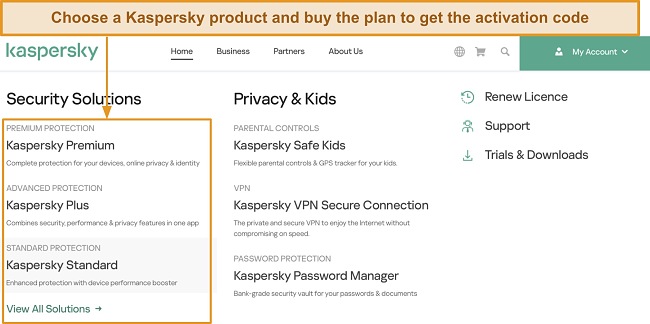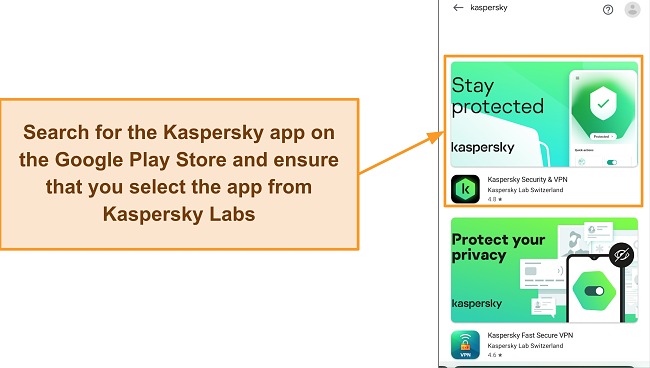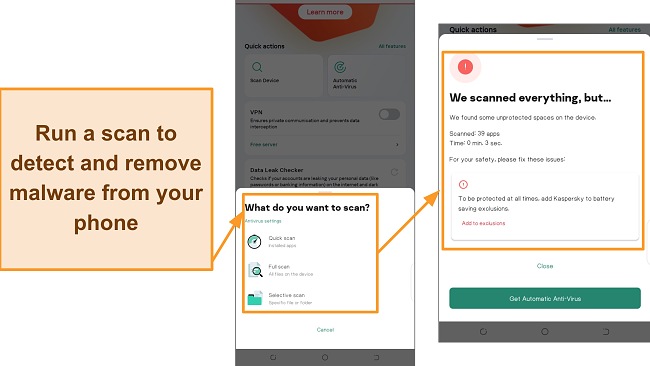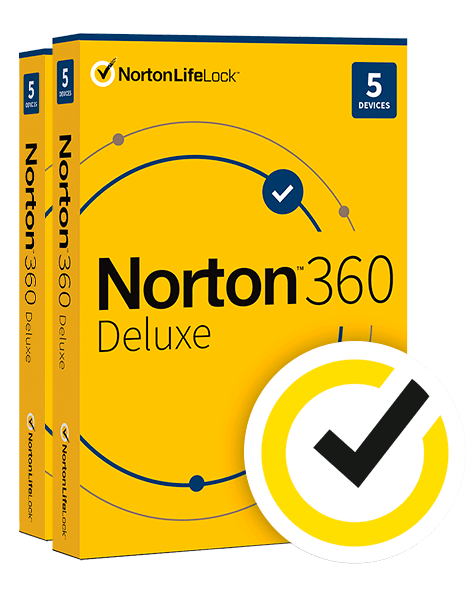Kaspersky vs Webroot 2024 — In-Depth Antivirus Comparison
Kaspersky and Webroot are 2 top names in the antivirus industry that claim to provide the best malware protection. I ran comprehensive tests across 15 categories to evaluate if they lived up to the hype.
While Webroot was incredibly light on my system and has a longer refund policy, I prefer Kaspersky as it outperformed Webroot in nearly all departments. It gave me excellent malware detection abilities and real-time protection scores.
You can try Kaspersky risk-free with its 30-day money-back guarantee. You can also sign up for its 30-day free trial without giving away your credit card details. Alternatively, you can get its free plan which has all the essential security features to keep you safe from threats.
Get Kaspersky risk-free for 30 days
No Time? Here’s a 1-Minute Summary of Category Winners
Kaspersky is better than Webroot in almost every aspect. It provides much better overall virus protection and real-time safety. Even Kaspersky’s free plan has more features than Webroot’s premium plans.
 |
 |
|
| Virus Scanner | Has 7 scan options and a powerful cloud-based anti-malware engine | Only has 2 scan options but offers decent virus detection abilities. |
| Real-Time Malware Protection | Detected 100% of complex malware in real-time | Detected 94% of all advanced threats in real-time tests |
| System Performance | Didn’t slow down my computer while browsing, installing software, or gaming | Didn’t slow down my computer and it took fewer resources |
| VPN | Has 85+ global servers, military-grade encryption, and a kill switch | ✘ |
| Parental Controls | Remotely monitor child devices to protect them from potential threats | ✘ |
| Firewall | Has a configurable firewall with many advanced features | Has a firewall but lacks advanced features like Stealth Mode |
| Password Manager | Uses a proprietary password manager and is easier to use with better auto-fill abilities | Uses LastPass, which was recently involved in a data breach |
| Gaming Mode | Suspends notifications in full-screen mode and postpones scheduled scans while gaming | Blocks notifications while you’re gaming and suspends scheduled scans for lag-free gaming |
| Optimization Tools | Provides a range of tune-up tools that substantially improve performance | Has a system optimizer that is essentially a junk cleaner |
| Other Features | Offers webcam and mic protection, Safe Money, file shredder, and more | Only includes cloud storage on the premium plan |
| Device Compatibility | Works on a greater range of platform versions and is easier to use | Works on all major platforms but isn’t as user-friendly |
| Customer Service | Includes 24/7 live chat, email, and phone support with a detailed knowledge base | Doesn’t have live chat support, but lets you troubleshoot via email and online guides |
| Price | Offers excellent value for money with its feature-rich plans | Is relatively expensive as it lacks features like parental controls and a VPN |
| Free Version | Provides all the essential features in the free plan like real-time protection | ✘ |
| Money-Back Guarantee | Offers a 30-day free trial and a 30-day money-back guarantee | Includes a 14-day free trial and a 70-day money-back guarantee |
Use Kaspersky for complete protection
How I Tested and Compared Kaspersky vs Webroot
To accurately compare Kaspersky and Webroot, I conducted a series of tests across 15 categories to see which contender is better.
- Virus Scanner — I evaluated scan options available in each antivirus and tested their detection rates using a set of known malware samples.
- Real-Time Malware Protection — I analyzed the real-time protection offered by each antivirus and checked their effectiveness in detecting and blocking malware in real time.
- System Performance — I assessed each antivirus’ impact on system performance, paying attention to CPU usage and memory consumption.
- VPN — I considered if the 2 competitors offered a VPN and checked its performance and specs, like the number of global servers, speeds, and security features.
- Parental Controls — I used parental controls and checked if I could remotely monitor and control child devices.
- Firewall — I assessed the firewall capabilities of each antivirus software, focusing on their ability to offer robust online protection and advanced features.
- Password Manager — I checked the capabilities of the password manager of each contender, such as auto-fill capabilities and ease of use.
- Gaming Mode — I tested the gaming modes offered by each competitor, analyzing how effectively they allocated system resources while gaming.
- Optimization Tools — I considered the number and effectiveness of optimization tools provided by each antivirus and the impact they had on my system performance.
- Other Features — I accounted for useful extra features offered by each antivirus, such as transaction safety, webcam protection, and cloud storage.
- Device Compatibility — I made sure each antivirus works on Windows, macOS, iOS, and Android and evaluated them on ease of use.
- Customer Service — I tested each contender’s support options and gauged them on response times and level of helpfulness.
- Price — I compared the price plans of each antivirus to see which offered the better value for money.
- Free Version — I checked whether each antivirus offers a free plan and if it’s loaded with necessary security features like real-time protection.
- Money-Back Guarantee — I tested each competitor’s refund policy firsthand and evaluated how long it took to get my money back.
Protect yourself with Kaspersky
1. Virus Scanner — Kaspersky Has More Scan Options and Better Detection Abilities
After running several tests, Kaspersky averaged a near-perfect detection score of 99.9% compared to Webroot’s 96%. My 150 virus samples included trojans, worms, adware, ransomware, rootkits, keyloggers, and more. Kaspersky detected all malware except a metamorphic virus packed inside a zip file.
Kaspersky cross-checks scanned files against its extensive malware library to identify potential threats. It further uses machine learning algorithms to conduct a more in-depth analysis and identify any suspicious behaviors exhibited by the programs on your computer. Usually, this method yields false positives but Kaspersky only flagged 1 legitimate file.
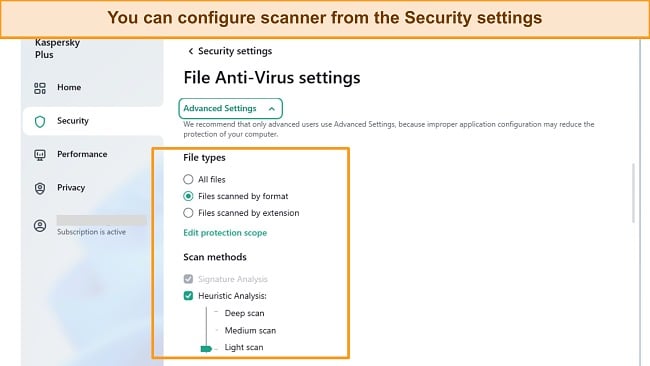
Like Kaspersky, Webroot has a cloud-based virus scanner that uses heuristic analysis to detect fast-emerging threats. Unfortunately, it gave me a below-average detection score and was particularly weak against viruses hiding inside zip files, which are quite difficult to detect.
Webroot’s deep scan was slightly faster than Kaspersky’s, taking 25 minutes to analyze 500,000+ files on my PC. Compared to Webroot’s 2 scan types, Kaspersky offers more flexibility with its 7 scan options below, my favorite being the Application Vulnerability Scan.
- Full scan — checks your entire hard drive for viruses and potentially unwanted programs (PUPs).
- Quick scan — rapidly scans locations where infections are most likely to be found.
- Selective scan — lets you choose a specific folder to scan.
- Instant file scan — thoroughly inspects specific items like zip files for malware.
- Removable drive scan — examines external hard drives and flash drives.
- Background scan — keeps Kaspersky’s scan running when your computer goes into sleep mode.
- Application Vulnerability scan — checks for vulnerabilities in all your apps, especially outdated ones.
Overall, Kaspersky’s virus scanner is more powerful against complex threats. It also has more scan options and a lower false positive rate. It even lets you create exceptions before scanning your system. For instance, you can add an app to exclusions and Kaspersky won’t scan it because you trust it.
Virus Scanner Winner: Kaspersky
2. Real-Time Malware Protection — Kaspersky Blocks 100% Of Real-Time Threats
Kaspersky outshined Webroot in my real-time detection tests by a big margin. It kept me safe from all malicious sites, downloads, and spam emails in real time. In contrast, Webroot didn’t identify half of the complex real-time threats like zero-day exploits known for using your software’s vulnerabilities to launch a targeted attack.
I was thoroughly impressed by Kaspersky’s real-time protection built upon its proprietary infrastructure called the KSN (Kaspersky Security Network). It uses AI and human experts to analyze data via algorithms to immediately block potential threats. For instance, it blocked me from downloading 10+ malware-infested zip files and opening malicious sites.
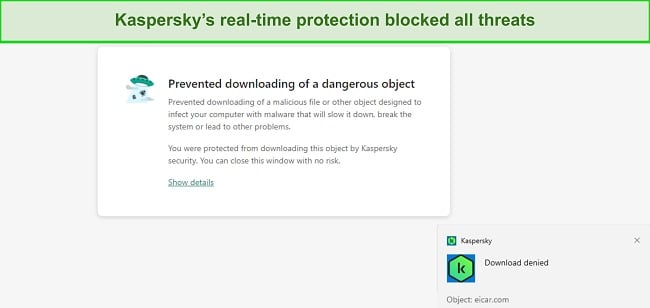
Additionally, Kaspersky’s System Watcher automatically detects suspicious file behavior, preventing hackers from taking your sensitive files hostage. Plus, you get mail protection as Kaspersky scans all your incoming and outgoing emails and blocks those with malicious URLs or attachments.
In contrast, Webroot only blocked 8 out of 25 real-time threats I exposed it to — that’s an unsettling score. However, it gave me excellent online protection with its Web Threat Shield browser extension that marked safe websites on Google’s SERPs with a green tick and unsafe sites with a red one. It’s compatible with Chrome, Firefox, Edge, and Safari.
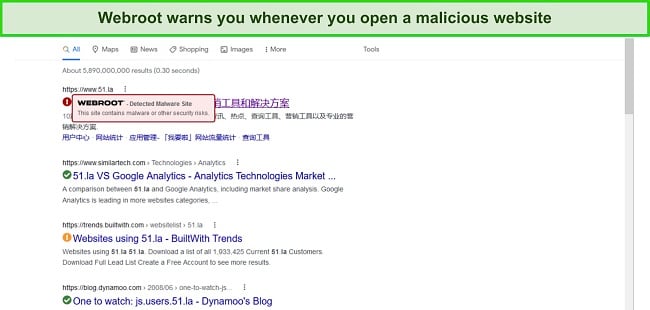
It also includes phishing protection to keep you safe from hackers sending you fraudulent emails. In my tests, Webroot blocked 97% of all spam messages with infected URLs. But I found it had missed a few keyloggers when I ran a deep scan later.
While Webroot kept me sufficiently secure online, I couldn’t rely on it to protect me from complex real-time threats. On the other hand, Kaspersky blocked every real-time threat and gave me complete peace of mind while browsing the internet.
Real-Time Malware Protection Winner: Kaspersky
3. System Performance — Webroot’s Scans Were Lighter on My Computer
Neither Kaspersky nor Webroot slowed down my PC, but Webroot was slightly lighter. To test the performance slowdown, I recorded my baseline averages and noted the percentage increases across multiple categories, such as RAM and CPU usage. I noted each contender’s impact on my browsing experience, especially while installing resource-heavy software like AutoCAD and Adobe Photoshop.
| % RAM usage increase during a full scan | % CPU usage increase during a full scan | Time increase launching 10 sites at once | Time increase in installing heavy software | |
| Kaspersky | 22% | 30% | 5 seconds | 22 seconds |
| Webroot | 17% | 24% | 3 seconds | 19 seconds |
While the numbers are in favor of Webroot, I noticed that its full scan checked fewer files than Kaspersky. That explains why it consumed fewer resources, but I don’t mind waiting a few extra minutes while browsing the web or installing software. For even faster scans, I recommend Norton as its full scan only took 11 minutes to check all files on my hard drive without slowing my PC even a bit.
System Performance Winner: Webroot
4. VPN — Kaspersky’s VPN Offers Better Speeds and Unblocking Abilities
Kaspersky’s Secure Connection VPN is a must-have if you’re traveling and want to access your home content. It’s also available on the free plan with a 200MB daily allowance, which is barely enough for casual browsing. Still, at least Kaspersky includes a VPN, unlike Webroot.
On the paid plan, you’ll have unlimited data with Kaspersky’s VPN. It has 85+ servers across the globe for easily accessing global sites and services from anywhere. While it’s not as extensive as a standalone VPN like ExpressVPN, it’s enough for secure and lag-free streaming on popular platforms like Netflix, Disney+, and HBO Max.
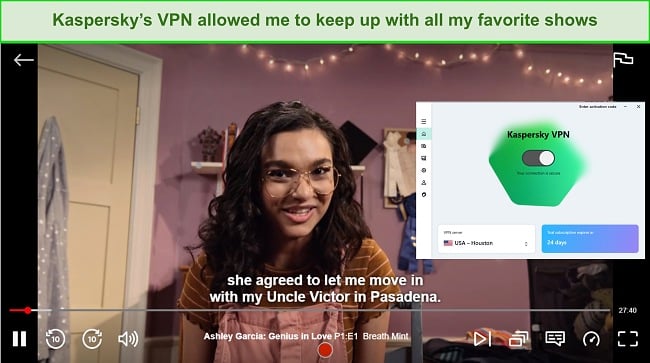
Besides streaming, Kaspersky’s VPN passed my DNS, IP, and WebRTC leak tests, ensuring my IP address remained hidden. It uses military-grade 256-bit encryption to make your internet traffic virtually unhackable. Even if the server unexpectedly drops, the kill switch will automatically disconnect you from the internet, preventing your IP address from being accidentally exposed.
VPN Winner: Kaspersky
5. Parental Controls — Kaspersky Safe Kids Let You Monitor Child Devices Remotely
Kaspersky wins this round again as Webroot doesn’t offer parental controls, even on its top-tier plan. Meanwhile, Kaspersky’s Safe Kids lets you remotely monitor and protect your children’s devices. While it’s available in the Kaspersky suite, you’ll have to download the Safe Kids app to enable parental controls. Safe Kids includes:
- Websites and app filtering — lets you block inappropriate websites and apps on your child’s device, so they’re not exposed to harmful or explicit content online.
- Screen-time controls — limit the amount of time your child can spend on their device, helping to balance screen time with other activities.
- YouTube monitoring — monitors your child’s YouTube searches and alerts you if they try to access blocked sites or apps in real time.
- Location tracking — tells you your child’s location in real time, ensuring their safety when they are out and about.
- Geofencing — creates a virtual boundary around a specific area, such as a park or school, and alerts you if your child leaves the area.
In my tests, Safe Kids’ web filtering feature blocked adult and gambling sites. I liked that instead of specifying certain URLs, I could select a category of sites I wanted to block. The interface was easy to make sense of. It took me less than a minute to link a device remotely and set screen time and access limits.
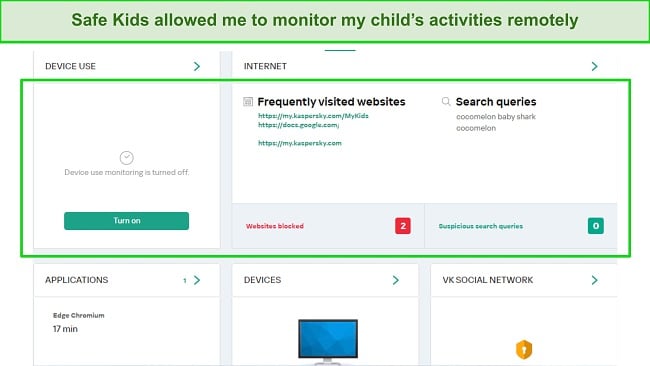
The free version of Safe Kids is enough for most users as it includes web filtering, screen time limits, and app blocking. However, premium users get access to live GPS location tracking, Facebook activity, real-time alerts, and safe area settings. Overall, Kaspersky Safe Kids is comparable to other premium parental controls like Norton and McAfee.
Parental Controls Winner: Kaspersky
6. Firewall — Kaspersky’s Smart Firewall Gives You Complete Control Over Your Internet Traffic
After comparing the two, Kaspersky’s firewall was more powerful and customizable than Webroot’s. It lets you create application and packet rules, giving you complete control of your incoming and outgoing traffic. Intrusion Prevention monitors all running processes on your system and blocks suspicious attempts to connect to the internet. It also includes:
- Network Monitor — lets you view and analyze your network traffic and shows all active network connections.
- Network Attack Blocker — prevents malicious actors from getting into your system via network vulnerabilities, especially on unsecured public WiFi.
- Smart Home Monitor — displays your home WiFi and all the devices connected to it, so you can be alerted to any stranger using your network.
Kaspersky’s firewall keeps you protected until you turn off your computer. This unique feature gave me peace of mind while using my PC even when Kaspersky wasn’t running in the background. The overall firewall interface was straightforward, but it’d be better if all the network protection features were grouped under the firewall tab — I found them scattered in the Security tab.
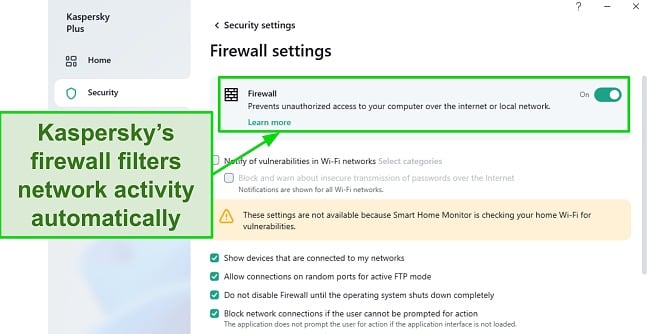
Webroot’s firewall is decent for online security but lacks advanced features like Stealth Mode. But it’s still better than Microsoft’s in-built firewall as Windows Defender isn’t powerful enough against complex threats like zero-day malware. However, it includes packet filtering to block malicious traffic and intrusion detection to prevent any hacker from taking over your computer.
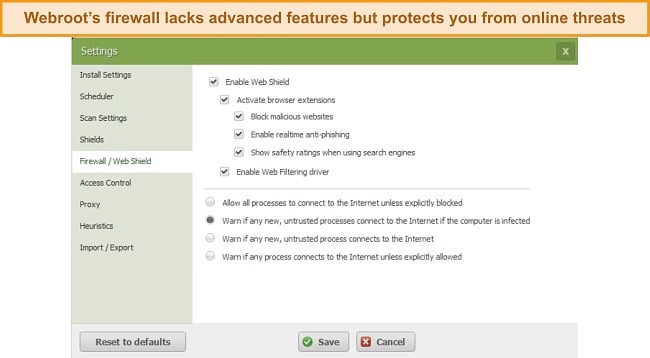
For basic use, Webroot’s firewall does the job but I preferred Kaspersky’s advanced and configurable firewall for better online security. However, that doesn’t mean Kaspersky is perfect as cyber threats are always evolving. You should always adopt healthy browsing habits and not click on shady links on unverified sources.
Firewall Winner: Kaspersky
7. Password Manager — Kaspersky’s Password Manager Has Better Auto-Fill Functionality
After using both contenders, I found Kaspersky’s password manager more feature-rich with better auto-fill capabilities. It lets you store various sensitive data like your bank details, credit card numbers, user credentials, documents, and addresses. I found its password generator incredibly useful while signing up on sites, creating strong passwords in just a click.
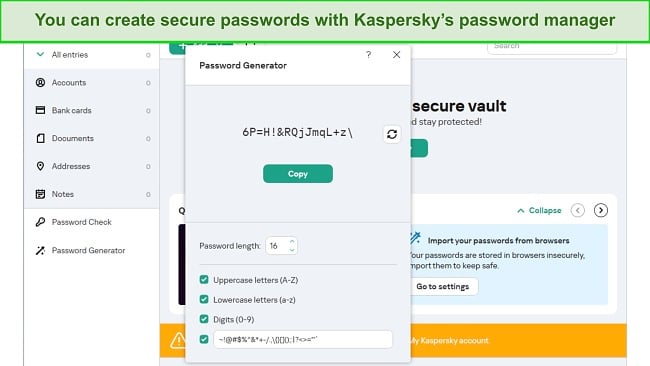
To use Kaspersky’s password manager, I had to install a separate app, sign in with my Kaspersky account, and create a master password to set up my vault. You can also use it as a browser extension on Chrome, Firefox, Safari, and Edge. Kaspersky includes all the top-tier features found in standalone password managers like 1Password such as:
- Password strength checker — identifies weak, compromised, and reused passwords and prompts you to change them immediately.
- Auto-fill — automatically fills your data on website login pages and complex web forms that include personal information like address and bank details.
- Military-grade encryption — uses a powerful 256-bit cipher to encode your data at the local level to make it impenetrable to potential hackers.
Webroot uses a whitelisted version of LastPass, a renowned password manager. It uses military-grade encryption and includes 2-factor authentication, which is missing from Kaspersky’s password manager. You can save your data in 4 core categories, namely emails, finances, medical, and networking.
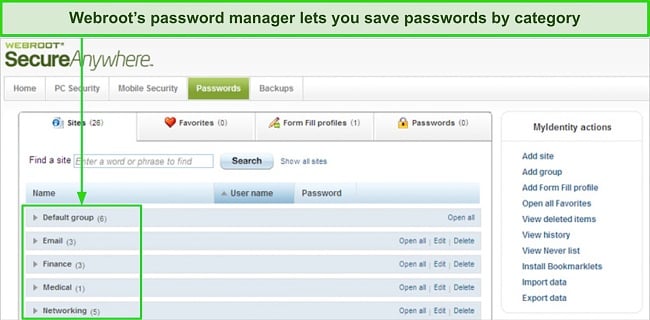
However, the only reason why Kaspersky is ahead in this department is because LastPass was involved in a data breach in 2022. The company said that there was a misconfiguration in its cloud infrastructure, which has been fixed. Besides that, Webroot’s auto-fill function didn’t work as seamlessly on complex web forms as Kaspersky’s.
Password Manager Winner: Kaspersky
8. Gaming Mode — Both Antivirus Gaming Modes Yield Similar Performance
Both Kaspersky and Webroot use a few system resources to ensure lag-free gaming. The only difference is that Kaspersky has a dedicated gaming mode, whereas Webroot’s standard plans don’t. However, I got a similar performance with both contenders.
Kaspersky’s Game Mode automatically suspended non-critical notifications and postponed scheduled scans. It does that when you’re in full-screen mode to provide an uninterrupted gaming experience. I played Forza Horizon 5 for over an hour without any frame drops or annoying pop-up notifications from Kaspersky.
While its normal plans don’t have a dedicated gaming mode, Webroot’s AntiVirus for PC Gamers plan suspends notifications and scheduled scans during gameplay. It worked seamlessly as I played The Witcher 3 on my PC. I didn’t get any frame drops while Webroot’s full scan was running in the background. That’s because its cloud scanning consumes very few system resources.
Overall, both contenders are fine for gaming but not as good as Norton 360 for Gamers. Norton GO gives you an instant power boost while gaming. It automatically allocates CPU cores for games, freeing them from other tasks.
Gaming Mode Winner: Draw
9. Optimization Tools — Kaspersky’s Tune-up Tools Improve System Performance Considerably
Kaspersky has a wide range of useful optimization tools that significantly improved my system performance. Webroot’s tune-up facility is pretty good, but it’s more focused on junk cleaning. Kaspersky’s standout optimization tool is its Hard Drive Health Monitor. It constantly indicates the overall health of your hard drive, so you can keep your sensitive data backed up in case the drive crashes.
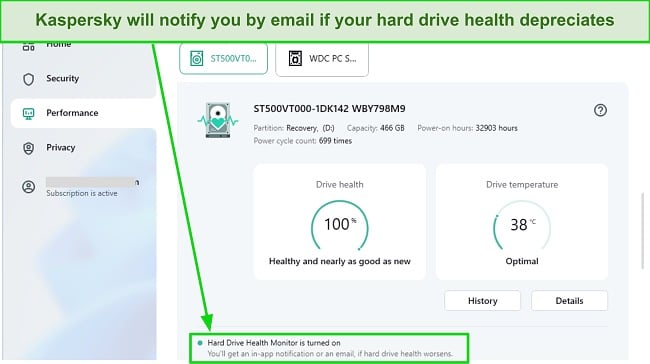
I ran the Quick Startup tool and Kaspersky identified autorun programs. This allowed me to remove autorun apps slowing down my system. Similarly, the PC Speed-Up tool detected 700MB of temporary system files and 8 registry issues — removing them took a few clicks and improved my system performance substantially. Besides that, Kaspersky includes:
- Duplicate File Finder — scans your system for duplicate files, such as documents, photos, and music, and helps you remove them to free up space on your hard drive.
- Unused App Checker — finds applications you haven’t used in at least 3 months and recommends you remove them to save space and improve performance.
- Privacy Cleaner — clears traces of your activity on your PC, including browser cookies, to protect your privacy and keep your computer running smoothly.
- Battery Saver — postpones scans and updates when your laptop is off-charge, helping to save battery life.
Webroot’s System Optimizer is essentially a junk file remover. In my tests, it removed 800MB of duplicates, junk files, and other useless data to improve my PC’s performance. The impact was noticeable while browsing multiple tabs and installing programs like Adobe.
While Webroot’s System Optimizer is decent for improving system performance, it’s mainly a junk remover. In contrast, Kaspersky’s optimization tools are much more comprehensive and diverse. The only issue is that they’re scattered across multiple tabs instead of being grouped into one.
Optimization Tools Winner: Kaspersky
10. Other Features — Kaspersky Has More Useful Extras Including Privacy Protection
Kaspersky wins this round again as it has so many useful extras that Webroot doesn’t. I was disappointed that Webroot has nothing extra to offer except for cloud storage which is only available on the premium plan. However, syncing data was easy with Webroot. I marked folders I wanted to back up, and they were automatically uploaded to the cloud.
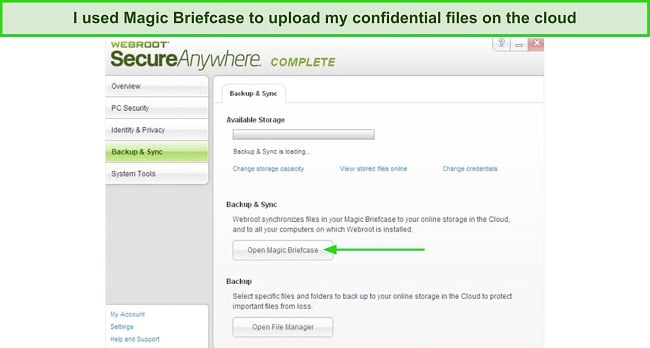
On the other hand, Kaspersky offers webcam protection, cloud storage, secure online transactions, and a file shredder. Webcams are quite vulnerable to hackers as they don’t have any in-built security. With Kaspersky, I was assured no one could hack into my webcam and mic to spy on me.
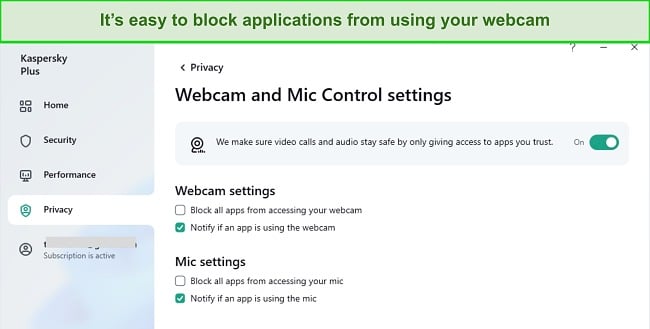
Kaspersky’s Safe Money feature secures your online transactions. It uses a protected browser to isolate financial activities, preventing phishing and other online frauds. It also verifies the security of the website you are accessing, making sure that it’s not fake or malicious.
With Kaspersky’s file shredder, you can permanently delete sensitive files beyond recovery. A standard deletion doesn’t entirely remove files and can be recovered by a potential hacker. The file shredder overwrites the removed file with random data, making it impossible to be retrieved.
Overall, Kaspersky offers more privacy-focused tools to protect you from online and offline threats. In contrast, Webroot includes cloud storage — and only on its premium plan.
Other Features Winner: Kaspersky
11. Device Compatibility — Kaspersky Works on More Platform Versions and Is Easier to Use
After using both antiviruses, I found Kaspersky’s user interfaces across apps more intuitive and easier to use. While Webroot has a pretty straightforward layout as well, it appears clunky and complex at first glance. However, installing both contenders was easy and took less than 10 minutes on my Windows laptop, MacBook, iPhone, and Android phone. Below is a chart detailing the operating systems each competitor is compatible with:
| Windows | macOS | iOS | Android | |
| Kaspersky | Windows 7 or higher | macOS 10.14 or higher | iOS 12 or higher | Android 4.4 or higher |
| Webroot | Windows 7 or higher | macOS 10.14 or higher | iOS 13 or higher | Android 8.0 or higher |
The first thing I noticed while using Kaspersky was its minimal interface. Both the Windows and macOS apps have a similar layout, so I didn’t have to waste time getting familiar with each. You’ll see the Home, Security, Performance, and Privacy tabs neatly arranged on the left pane for easy access to all features.
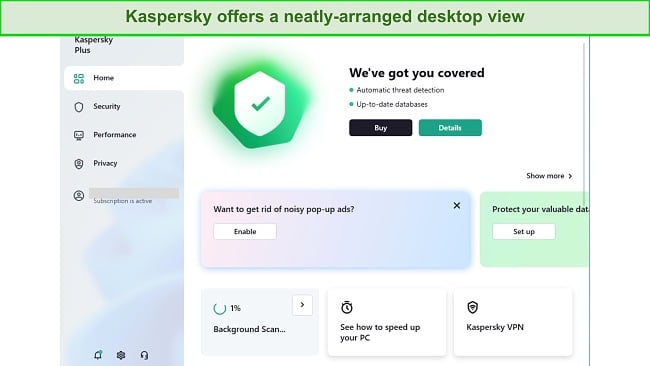
Webroot’s apps have a similar interface too with all the features flushed to the right. However, I found the layout and the green color theme a bit off. Scheduling scans was pretty easy with Webroot — it lets you set the scan frequency, time, and rules like preventing Webroot from starting a scan when your laptop isn’t charging.
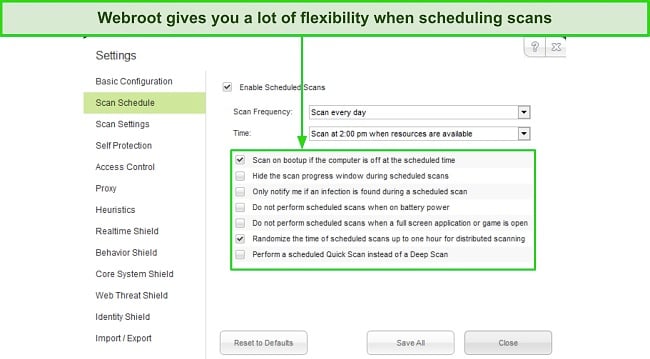
Overall, both contenders are beginner-friendly but Kaspersky has a slight edge mainly due to its modern and minimal interface. Plus, it’s compatible with a greater range of OS versions, so you can use it on relatively older devices.
Device Compatibility Winner: Kaspersky
12. Customer Service — Kaspersky Has 24/7 Live Chat With Fast Troubleshooting
While both antiviruses have reliable customer support, I prefer Kaspersky because it offers 24/7 live chat. It’s available in multiple languages, including English, German, Spanish, Dutch, and more. I had to fill out a form on its website before I could connect with a representative. I asked the support agent how to set up parental controls and got a prompt reply.
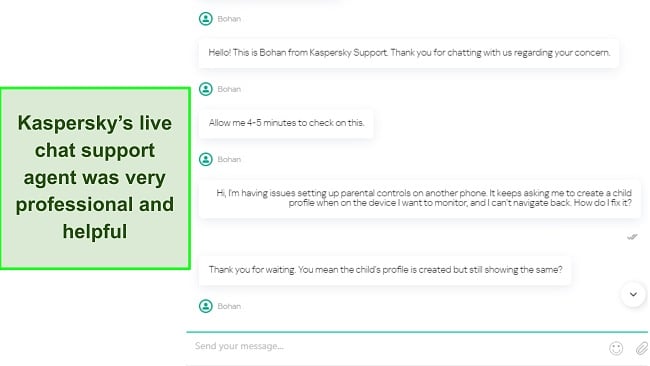
If you have a technical issue, I suggest using Kaspersky’s 24/7 email support. You have to fill out the same form, type your query in the description box, and click submit. I got a reply from the support team after 7 hours, which is a decent response time. You can also use phone support for in-depth support, but I had to wait about 10 minutes before connecting to an agent.
You can solve most of your queries with Kaspersky’s comprehensive knowledge base on its website. It has FAQs and how-to guides for all operating systems it supports. There’s also an online forum where you can find a lot of helpful responses for troubleshooting questions.
Webroot doesn’t offer live chat support, which was disappointing. However, its email support more than makes up for it. I generated 2 email tickets on Webroot’s websites and both were resolved in 10 hours. The responses I received were comprehensive and fully resolved my queries. You can find answers to most of your queries via Webroot’s online knowledge base.
In summary, Webroot’s lack of 24/7 live chat customer support means Kaspersky wins this round. Even in other areas like email and phone support, Kaspersky’s response times were considerably faster than Webroot’s.
Customer Service Winner: Kaspersky
13. Price — Kaspersky Is Considerably Cheaper and More Feature-Rich Than Webroot
After comparing both contenders’ price plans, Kaspersky’s plans are much more value friendly. It offers more features on average even on its mid-tier plan. Here’s a breakdown of what you’ll get with Kaspersky’s plans:
| Kaspersky Standard Plan | Kaspersky Plus Plan | Kaspersky Premium Plan | |
| Price | $38.49 per year | $38.49 per year | $38.49 per year |
| Real-time protection | ✔ | ✔ | ✔ |
| Firewall | ✔ | ✔ | ✔ |
| Optimization tools | ✔ | ✔ | ✔ |
| Stalkware protection | ✔ | ✔ | ✔ |
| Drive health monitor | ✘ | ✔ | ✔ |
| VPN | ✘ | ✔ | ✔ |
| Password manager | ✘ | ✔ | ✔ |
| Data leak checker | ✘ | ✘ | ✔ |
| Parental controls | ✘ | ✘ | ✔ |
| ID protection wallet | ✘ | ✘ | ✔ |
In comparison, Webroot’s plans have fewer features. Not to mention that its virus-detection capabilities are less powerful than Kaspersky’s. Here’s what you’ll get with each of Webroot’s plans:
| AntiVirus | Internet Security Plus | Internet Security Complete | Webroot Premium | |
| Real-time protection | ✔ | ✔ | ✔ | ✔ |
| Firewall | ✔ | ✔ | ✔ | ✔ |
| Ransomware protection | ✔ | ✔ | ✔ | ✔ |
| Web Threat Shield | ✘ | ✔ | ✔ | ✔ |
| Optimization tools | ✘ | ✘ | ✔ | ✔ |
| Dark web monitoring | ✘ | ✘ | ✘ | ✔ |
| Identity monitoring | ✘ | ✘ | ✘ | ✔ |
Overall, Kaspersky is much more feature-rich than Webroot. For instance, its basic plan has optimization tools whereas Webroot begins offering it on high-tier plans. Therefore, Kaspersky provides much better value than Webroot.
Price Winner: Kaspersky
14. Free Version — Kaspersky Has a Free Version but Webroot Doesn’t
I was impressed with Kaspersky’s feature-rich free plan. In contrast, Webroot doesn’t have a free version. With Kaspersky Free, you get: ransomware protection, a data leak checker, a network attack blocker, and:
- Ransomware protection — protects you against phishing attacks, preventing hackers from taking your files hostage.
- Data leak checker — checks your email addresses for leaked information due to data breaches.
- Network Attack Blocker — scans incoming traffic and connections and blocks any suspicious data packets from reaching your device.
- VPN — gives you access to global platforms with a 200MB daily limit, which can be increased to 500MB.
- Parental controls — let you remotely access and protect child devices.
- Password manager — allows you to save up to 15 passwords on the free plan.
Many free antiviruses have severe limitations and don’t even include real-time protection. However, you can try these 3 truly free Windows antiviruses as they gave me decent results. Kaspersky’s free plan also has all the essential security features. However, I’d still prefer its paid plans for useful extras like the Hard Drive Health Monitor.
Free Version Winner: Kaspersky
15. Money-Back Guarantee — Webroot Offers a Better Refund Policy
I found Webroot’s refund policy more friendly as it gives you 70 days to try the service risk-free. In addition, it also offers a 14-day free trial on all plans. In comparison, Kaspersky offers a 30-day money-back guarantee. However, it’s only applicable if you buy directly from its website, not through the app store.
To get a refund from Kaspersky, I had to fill out a form on its website and connect with customer support. I got a confirmation reply after a day and the money came into my account after a week. Webroot’s refund process was similar — you have to provide your invoice information while filling out the refund form.

If you’re in the US, UK, Australia, or Ireland, getting a refund would be easier via phone support. Just dial the support line and request the billing agent for a refund. Remember to keep your invoice information ready as you may need to provide it to claim your money back.
Money-Back Guarantee Winner: Webroot
And the Winner Is… Kaspersky
After comparing Kaspersky and Webroot, I’ve concluded that Kaspersky is a much better antivirus. It outshined Webroot in almost every category, giving me near-perfect detection scores. Kaspersky also offers many useful extras like optimization tools to improve system performance, parental controls, a password manager, and more.
- Virus Scanner — Kaspersky
- Real-Time Malware Protection — Kaspersky
- System Performance — Webroot
- VPN — Kaspersky
- Parental Controls — Kaspersky
- Firewall — Kaspersky
- Password Manager — Kaspersky
- Gaming Mode — Draw
- Optimization Tools — Kaspersky
- Other Features — Kaspersky
- Device Compatibility — Kaspersky
- Customer Service — Kaspersky
- Price — Kaspersky
- Free Version — Kaspersky
- Money-Back Guarantee — Webroot
While it lagged in some areas, Webroot is more lightweight than Kaspersky and offers a much longer refund window. However, it doesn’t include a VPN, parental controls, and advanced optimization tools. Webroot is good for basic virus protection, but overall its price bracket doesn’t justify its lack of features.
I’d choose Kaspersky’s free plan over Webroot’s paid plans. However, I recommend signing up for Kaspersky Plus so you can access extra features like Safe Money, Smart Home Monitor, a VPN with unlimited data, a password manager, and more. You can try Kaspersky risk-free for 30 days with its money-back guarantee.
Overall Winner: Kaspersky
How to Use Kaspersky on Your Device
- Choose a product — Buy a Kaspersky product that fits your needs. I recommend the Plus plan as it has all the premium features like hard drive health monitoring.
![Screenshot of Kaspersky's products displayed on its website]()
- Install Kaspersky — Download the app for your device. It supports Windows, macOS, iOS, and Android. I downloaded the Android app via Google Play Store.
![Screenshot of Kaspersky's app on Google Play Store]()
- Run a full scan — Do a full scan so that Kaspersky checks your entire system for malware and keeps you safe from threats.
![Screenshot of how to run Kaspersky's full scan after installing it on a device]()
FAQ: Kaspersky and Webroot
Is Kaspersky better than Webroot?
Yes, Kaspersky is a much better antivirus than Webroot. Kaspersky caught 100% of the malware samples I planted on my PC. It also detected all the real-time threats I exposed it to.
Kaspersky packs a wide range of useful extras like parental controls and a VPN, unlike Webroot. It’s also lightweight (though Webroot is lighter), so your computer won’t lag during casual browsing and gaming.
What devices can I use Kaspersky on?
Kaspersky is compatible with Windows, macOS, iOS, and Android. Check out this device compatibility chart to see which versions Kaspersky’s apps work on. I found all its apps incredibly easy to use — beginner users won’t have trouble finding features on its interface.
Some privacy features like Network Monitor and Intrusion Prevention are scattered across multiple tabs. Also, its iOS app lacks many features like a virus scanner, WiFi security checker, and data breach monitoring. I recommend these 5 best iOS-specific antiviruses to iPhone users.
Can I use a free antivirus instead of Kaspersky?
Yes, but I highly advise against it. Instead, you can use a top antivirus from this list for free with a money-back guarantee. My top recommendation is Norton as it boasts the best virus detection rates and comes with a 60-day refund policy.
While free antiviruses seem like a good deal, they have major drawbacks that can put your computer at risk. They lack the same level of protection and features as premium antiviruses. The worst of them come bundled with adware, spyware, or other malware, which can compromise your security and privacy.
Is Kaspersky Premium better than Webroot Premium?
Yes, Kaspersky’s premium plan is significantly better than Webroot’s top subscription. Check my detailed price comparison of each contender. Kaspersky Premium includes Safe Money, webcam protection, a data leak checker, hard drive health monitoring, and many other features that Webroot doesn’t. Here’s a detailed comparison of the 2 plans:
| Kaspersky Premium | Webroot Internet Security Complete | |
| Anti-phishing protection | ✔ | ✔ |
| Firewall | ✔ | ✔ |
| Gaming mode | ✔ | ✔ |
| Optimization tools | ✔ | ✔ |
| Safe Money | ✔ | ✘ |
| Unlimited VPN | ✔ | ✘ |
| Parental controls | ✔ | ✘ |
| File shredder | ✔ | ✘ |
Other Top Antiviruses in 2024
Editors’ Note: Private Internet Access, CyberGhost, Intego and Expressvpn are owned by Kape Technologies, our parent company.

